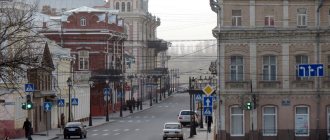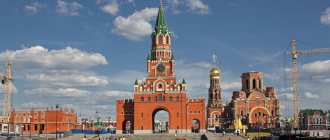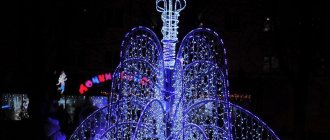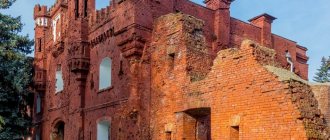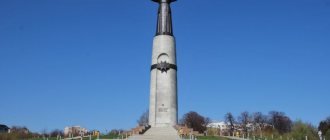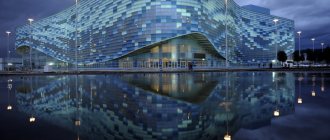- July 25, 2018
- Types of recreation
- Ruchkina Natalya
There are several places in Volgodonsk where you can have a good time. Conventionally, they can be divided into natural and artificial. Natural ones include recreation parks, and artificial ones include cafes, architectural monuments, etc. It all depends on what you want to do, what interests you more - walking around the city or going shopping.
Migration of the population of Volgodonsk
Migration in the city has recently increased and natural population decline has decreased somewhat. Thus, in the city of Volgodonsk in 2021, a population increase was registered due to migration processes, which amounted to 865 people (in 2015 - 110). The number of people who arrived in Volgodonsk in 2015 was 4,891 people, in 2016 - 5,319, the number of people who left the city in 2015 was 4,781 people, and in 2021 - 4,454 people. Most city dwellers migrate to neighboring cities of the Rostov region; in addition, migration flows are noted in Central Russia, the Volga region, the Moscow region and Moscow, the Volgograd region, the Urals, as well as to foreign countries.
Victory Park
Victory Park is one of the most famous park complexes designed for cultural events and recreation of the local population in Volgodonsk. The park is located in the old part of Volgodonsk.
There are numerous attractions here, thanks to which local residents prefer to walk in the park with their children on weekends.
According to tradition, on the eve of May 9th, memorial rallies are held annually, during which flowers are laid in the Garden of Memory, which is part of Victory Park. At the same time, on June 22 it is customary to hold traditional rallies in memory of the beginning of World War II.
Location: Gorky street - 77.
Embankment, Mound of Cossack Glory, monument to Baklanov
Volgodonsk has a very beautiful embankment, not inferior in picturesqueness and grooming to the embankments of large cities. Here, in the early 2000s, art objects dedicated to the Don Army, on whose ancestral lands the Soviet city was built, were erected. This is the Mound of Cossack Glory and a monument to the famous Cossack general Yakov Baklanov. The equestrian sculpture of one of the national heroes of the Don Cossacks rises 7 meters. And behind this monument there is a five-meter mound made of concrete, with relief images of the history of the Don. Between these art objects are a Cossack saddle and hat.
Monument to General Baklanov and Mound of Cossack Glory.
TOP-6 – what to see in Volgodonsk in 1 day
There are many places in Volgodonsk that have become calling cards of the entire region. Some of them are associated with large production facilities, such as hydroelectric power stations and nuclear power plants, others – with the Great Patriotic War.
Tsimlyansk Reservoir
Coordinates on the map: 47.655945, 42.275105.
One of the largest reservoirs created by human hands. The reservoir has become a kind of crossroads for a dozen rivers rich in fish, and the ruler of the nearby fields. A giant bowl waters the earth and more than three million inhabitants.
From here, electric current flows through the wires from one of the most important hydroelectric power stations in the country. The creation of Soviet builders even influenced the local climate: now the winter cold comes here later and does not give way to a warm spring for a long time.
Alley of Golden Families
Address: Park of Family, Love and Fidelity.
Next to the Volgodonsk registry office there is the most effective promotion of family values. The alley is a series of sculptural compositions. Each depicts crossed gold rings, in the center of which are photographs of married couples celebrating their sapphire wedding (45 years).
The alley symbolizes the strength of family ties and shows that all difficulties and adversities can be overcome with love and loyalty. The example of men and women who went through all the hardships of family life and maintained their marriage is intended to inspire young, inexperienced couples and spouses who are experiencing a crisis in their relationships.
Alley of Military Glory
Address: Victory Park.
Located in Victory Park. At the entrance to the alley, visitors are greeted by a bas-relief with its name. On the reverse side of the bas-relief, a Soviet liberator warrior is carved, with a star shining above his head.
The two paths are separated by a number of photographs of veterans of the Great Patriotic War and modern local wars. Under the photo there are inscriptions indicating the names of soldiers and officers, as well as the years and places of their service.
Memorial Glade of Hero Cities
Address: Victory Park.
Memorial installation of incredible beauty and symbolism in Volgodonsk. From the observation deck there are red paths, each of which ends with a shiny star with the name of the hero cities. Under each star there is a capsule with earth from the city indicated on the sign. In 2010, another star lit up in the horizon of memory - Rostov-on-Don.
Garden of Memory
Address: Victory Park.
Another beautiful memorial in Victory Park and the main meeting place for veterans. Twice a year - on Victory Day (May 9) and on the Day of Remembrance and Sorrow (June 22) - rallies are held here. At the entrance there is a sign in the form of a funeral wreath with the inscription.
The garden consists of two thousand trees. Each one was planted by relatives of those who never returned from the war. Every plant here is literally watered with the tears of widows, orphans and mothers. The idea of a garden is deeply symbolic, because a tree is life. The soldier is no more, but the tree grows and life goes on. Despite the grief, people still have hope for the future.
Vologda NPP Information Center
Address: Kurchatova Avenue, 22.
Volgodonsk received the nickname “the city of nuclear scientists” for a reason. One of the largest nuclear power plants in the country is located 16 km away. For local residents, the issue of peaceful and safe use of nuclear energy is more important than for anyone else.
After the horrific Chernobyl accident, people were concerned about plans to build a nuclear power plant in their area. The Atommash enterprise was on the verge of closure. An Information Center was created to educate and reassure the population.
Today the Center hosts scientific forums, seminars, and conferences on nuclear energy issues. There are exhibitions that clearly explain to visitors how nuclear energy is produced, how reactors are constructed, and how safe the operation of nuclear power plants is.
Alleys and parks
Volgodonsk (city attractions include alleys and parks) is famous for its outdoor recreation areas:
- Victory Park is the largest, most famous park complex in Volgodonsk. Located in the old district of the city, on the street. Gorky, 77. The place is equipped with a variety of attractions, comfortable gazebos and comfortable benches. All city public celebrations and events are held here.
- Yunost Park – founded in the spring of 1952 in the old quarter of the city. For several decades it was a center of cultural leisure. It hosted discos, concerts, and holiday events. Today the place attracts city dwellers who want to be in silence and enjoy the beautiful nature.
- Alley of Golden Families is a small area near the city registry office. Along the green spaces there are sculptures in the form of thin metal columns with gold rings on top. Each pair of pillars is connected by an openwork heart. At the intersection of 2 rings there are photographs of people who have been married for 45 years or more. The alley symbolizes fidelity, love and the value of marriage.
- Alley of Military Glory - located in Victory Park. It starts with a high pillar with a granite bas-relief. It depicts a warrior with a machine gun in his hands and the name of the alley is written. In the middle of the 2 paths there are flower beds and stands with portraits of participants in the war of 1941-1945. and veterans of the Afghan and Chechen companies. The alley was opened in May 1985 in honor of the 40th anniversary of the great Victory.
Ecological and Historical Museum
The history of the Don Cossacks is presented very richly, clearly and interestingly in the Volgodonsk Ecological and Historical Museum (formerly a local history museum, founded in 1969) - one of the largest museums in the region. It is located in three buildings. In the main one there are 12 exhibition halls, each of which is dedicated to the folk culture of the region in different historical eras. The museum collections include more than 70 thousand exhibits from archeology and paleontolia; iconography; rare books and documents; ancient coins and photographs; military relics; works of folk crafts from different times. Since 2003, the museum complex “Cossack Kuren” has been operating - the home and farmstead of the family of a 19th-century Don Cossack, recreated in life-size.
The building of the Ecological and Historical Museum of Volgodonsk.
Address: Lenin street, 52.
City museums
Volgodonsk (the city’s attractions are complemented by numerous cultural institutions) offers museums to visit:
- Art – has been operating since 1995. The art gallery introduces the work of famous Russian artists and local painters. These are still lifes, portraits, graphics, watercolors. In addition to works by artists, the museum's exhibitions include medals, photographs, memorial signs, and sculptures. Of particular interest to visitors is the exhibition of badges dedicated to the 1980 Olympics in Moscow.
- Ecological-historical is the largest museum in the eastern region of our country. Its holdings number about 102,000 items. The structure of the institution consists of 6 large departments. The museum has a personal library, a scientific laboratory and a restoration workshop. The exhibitions tell about the history of Volgodonsk, the emergence of the Great Steppe, and the territories of the Wild Field. Every year, the institution is visited by 126,000 city residents and visitors.
- Don culture, life and crafts is a department of the environmental and historical museum. Known as the “Cossack Kuren”, it contains authentic personal belongings of the Cossacks. Expositions and exhibitions introduce visitors to the crafts and life of the Cossacks. Hunting crafts, pottery and blacksmithing are widely represented. Rare exhibits include a Russian stove from the late 18th century, antique furniture, weapons, carpets, and clothing from the 19th century. The museum building, built in the 19th century, is classified as an architectural monument and is protected by the state.
Ethnographic seminars, conferences, and celebrations are held in the museum hall.
Volgodonsk Ecological and Historical Museum
This is one of the largest museums in the region, including 12 exhibition halls and a separate complex of the history of Don culture and life, which was mentioned above. The museum has more than 70,000 exhibits from different countries, including artifacts found as a result of archaeological and paleontological excavations, artistic and graphic paintings, objects of decorative and applied art, historical documents and photographs, books and coins. Separate exhibitions highlight icon painting from the Middle Ages to the present day, wooden sculptures, products made of precious metals (gold, silver), porcelain, and glass.
Statues and monuments
Relatively young Volgodonsk is interesting to city guests for its monuments:
- The sign of friendship between Russia and Bulgaria is dedicated to the 100th anniversary of the birth of the Bulgarian figure G. Dimitrov. Made in the form of a large yellow stone of a pentagonal shape. In the center of a kind of star is a portrait of Dimitrov. The memorial sign is located on the street. Morskoy, 68.
- Monument to Pushkin - opened in the spring of 1972. It has a stone base in the form of a book. In its upper part is the bronze face of the poet. Pushkin is depicted sad and drooping, with his gaze directed into the distance. The address of the monument is Pushkin Lane, 10.
- Motherhood - the monument is located next to the city maternity hospital. It consists of a wooden bench entwined with grapes and resembling a tree trunk. A tired woman is sitting on a bench holding a child. The composition symbolizes the fertility of the earth and female motherhood, located on the street. Sovetskaya, 45.
- The monument to the Muromsky spouses was opened in the fall of 2013 near the wedding palace. The author of the project is sculptor E. Derdiyashchenko. A man and a woman stand on a pedestal. Behind the loving couple you can see a pillar with an Orthodox cross and the inscription “the benefactors of marriage Peter and Fevronia.” The monument is located on the street. Lenina, 100.
- Monument to Yakov Baklanov - erected in 2008 on the banks of the Don River, near the city embankment. Made in the form of a mound with bas-reliefs placed on the plane, which depict historical scenes and Don Cossacks. Near the mound there is a horse with a dashing rider. This is a national hero who served in the Russian army for 42 years - Yakov Baklanov.
- Cossack at a cannon - the composition on Stroiteley Avenue is surrounded by a low stone fence. Consists of a cannon and several cannonballs on a stand. A Cossack sits nearby with a ladle in his left hand. He has a gun on his knees and a wide knife in his belt. In front of the Cossack there is a fountain made of rings of different diameters. It seems that the warrior guarding the gun is drinking water drawn from a fountain.
- Monument to the Builders - a 25-meter stele rises on Vesennaya Street. The facility was opened in 2011 as a tribute of gratitude and respect to the builders of Volgodonsk. The stele is directed into the sky, and a proud eagle sits at its very top. At the foot there are construction supplies: a trowel, a hammer, a helmet, and safety glasses.
- Peter I and Dmitry Cantemir - the monument was built in 2021 in Yunost Square. The author of the sketch is A. Vorontsov, the sculptor is P. Slobodchikov. Peter the Great holds a cup filled with berries. Cantemir holds a large bunch of grapes in his hands. Attached nearby is a table telling about the friendship of these famous people. The monument claims that it was from Moldova that grape bushes were brought to the banks of the Don. Since then, friendship between Russians and Moldovans began.
- Cossacks - a sculptural composition rises in the northwestern part of the city at the canal lock. Combines 2 9-meter columns and statues of horses with dashing riders. The wide pedestal is made of granite and decorated with inserts.
Fountains
Volgodonsk attracts tourists not only with museums, churches and spiritual parishes.
Fountains are also among the city's attractions:
Volgodonsk. Attractions: a fountain called Love.
| No. | Fountain name | Location | Short description |
| 1 | Sculptural composition “Love” | Street Marshal P.K. Koshevogo, next to building No. 3 (Machine Builders Square) | The fountain was opened in 1984. The author of the composition is sculptor V. Polyakov. The fountain is made in the form of a circle on which a pair of lovers sits. The young man has a guitar in his hands. In summer and autumn the fountain is open from Friday to Sunday. |
| 2 | Color | I.V. Kurchatov Square | Restored and opened in 2013. It has the shape of a bowl in which illuminated pumps are installed. Modern equipment provides the number, height and color of the jets. |
| 3 | Fountain | Yunost Square | The project architect is L. Vyguzova. Opening time: 1979. The fountain represents a large circle with open pearl-colored shells. |
| 4 | Fountain | Victory Park | Opened in early May 1985. Repeats the shape of a five-pointed star. In the center there are 2 sculptures of warriors with a victory banner in their hands. Under their feet one can see the fragments of a German cross. |
General information and history of the city
Volgodonsk is a very young city; three generations of residents have not yet replaced it. The city owes its appearance to a gigantic Soviet construction project - the digging of the Volgodonsk Canal, connecting two great Russian rivers - the Don and the Volga. Work began in 1949, thousands of workers arrived, and a settlement was organized to house them. The workers' settlement Novo-Solenovsky, intended after construction for the residence of workers servicing the Tsimlyansky hydroelectric complex, and in it in 1950 the industrial construction of multi-storey buildings began. This date became the founding day of Volgodonsk.
Volgodonsk in Soviet times
In 1958, a huge chemical plant was built, and the workers' settlement was given the title of city. In 1975, it was launched, and to improve the life of its workers, they began to build up the left bank of the Sukho-Solenovsky Bay of the Tsimlyansk Reservoir, the current New Town.
In 1977, it was decided to build a nuclear power plant in Volgodonsk. Work had begun, and the first building was almost completely erected when the explosion occurred at the Chernobyl nuclear power plant. Residents of the city, frightened by such a prospect from the use of nuclear energy, and even fueled by city politicians (who made a career out of it), organized pickets and rallies. As a result, in 1990, a decision was made to stop construction.
Embankment in Volgodonsk. Monument to Cossack General Ya.P. Baklanov
The nineties of the last century were difficult for the city. The city-forming enterprise, Atommash, received 2 times fewer orders than before, unemployment increased and the criminal situation worsened. In this situation, a decision was made in 1998 to resume construction of the nuclear power plant, which was commissioned in 2001, giving work to thousands of citizens.
Although the city was built after World War II, it cannot be said that it did not see the horrors of war. On September 16, 1999, at six o'clock in the morning, a residential building on Oktyabrskoye Highway was blown up. The attack killed 18 people.
House damaged in terrorist attack
Currently, the city is experiencing a rebirth; the influx of investment in industry and construction has increased significantly.
Other interesting places
Volgodonsk (attractions attract thousands of tourists every year) offers residents and visitors leisure and entertainment. These are camp sites, holiday homes, cafes, gaming centers, theaters.
They are located both in the city and in its environs:
- Tsimlyansky Wine Factory – works in the town of Tsimlyansk, located next to Volgodonsk. Founded in 1786. Produces sparkling wine and classic champagne. The plant has its own vineyards with more than 25 varieties of sunny berries. The administration of the enterprise has developed excursions for those wishing to visit the workshops and watch the production of wines.
- The information center of the Volgodonsk NPP is located in the city center in a new, modern building. Its task is to inform people about scientific events in the field of nuclear energy. An exhibition of the achievements of the nuclear and nuclear industry is framed and available for viewing in the building. In addition, the center has a complex that includes exhibitions with models of nuclear power plant equipment and reactors.
- The quest “The Birth of Volgodonsk” begins from V.I. Lenin Square. Attracts with the absence of a guide and unusual tasks. Requires personal participation of those interested with phones connected to the Internet. Participants in the quest receive a task on their phone, they solve it and send the answer to the specified address. If the answer is correct, the player receives the next task. Along the way of the quest, you will come across unique memorable places that tell about the history of the city, its attractions and honorary residents.
- City embankment – a favorite place for walks and recreation for city residents. Until 2000, in its place there was an abandoned wasteland with reeds growing. After the decree of the city administration, the unkempt embankment was equipped and beautified. Flowerbeds, lanterns, benches, trays with water and ice cream appeared. On summer evenings, musicians play and sing on the embankment. The cultural center staff conducts games, quizzes, and master classes.
- Laser tag club invites lovers of drive and incredible sensations. An exciting game using electronics and models of real weapons will not leave club visitors indifferent. Laser tag helps relieve stress, improve physical capabilities, and teaches you how to work in a team.
- Nightclubs are open until 7 am. They offer a varied menu, music, stripper performances, billiards, and bowling. Each of the 4 available nightlife establishments is equipped with a dance floor and an area for VIPs. Provides home delivery services upon pre-order.
Monuments of the sculptor Motovilov: “Worker and Riverman”, “Cossacks”
In 1953, magnificent monuments of the Soviet era appeared in Volgodonsk, and to this day they are among the main attractions of the city. Their authors were the famous sculptor, Honored Artist of the RSFSR Georgy Motovilov. In front of the building of the Administration of Hydraulic Constructions (now this is the city administration building) a monument to the working class was erected - the sculptural composition “Worker and Riverman”. The pedestal represents the open navigation bridge of a ship. The riverman is holding binoculars, and the hydraulic construction worker is holding a scroll, possibly a construction plan. The prototype of the worker was foreman Georgy Shpachenko, later an Honorary Citizen of the city of Volgodonsk.
"Worker and Riverman."
Another beautiful monumental composition by Motovilov is located on the northwestern outskirts of the city. It adorns the fifteenth lock of the canal. The monument to the Cossacks consists of two nine-meter tower-columns located on both sides of the last, 15th Volga-Don gateway. There are statues of dashing horsemen waving sabers on rearing horses. The pedestals, 4.5 m wide, are made in the spirit of early classicism and decorated with a paneled belt.
"Cossacks".
Paintball, laser tag
If you want to run, jump and shoot, then you will like paintball. This is a military sports team game. To play it, you need to go to a club called “Adrenaline” on Otdyha Street.
Have you ever watched the movie "Star Wars"? Then you will like laser tag, which is located on Entuziastov Street. You and your opponent are given lasers, and you must fight in a real fight. It's actually safe because the beam has sensors. Laser tag is played inside a special room, but you can also have a battle outdoors. Both adults and children can play this game.
Museum of the History of Don Folk Culture, Life and Crafts
This museum is also known as the “Cossack kuren of the 19th century”. The museum belongs to the city historical museum of Volgodonsk. The museum is a life-size recreated home and farmstead of a Cossack family. The museums present exhibitions reflecting the features of the traditional culture of the Cossacks and their way of life.
Separate exhibitions are devoted to the peculiarities of folk arts and crafts - hunting, fishing, blacksmithing, wickerwork, carpentry and pottery. Even the museum building itself is an architectural monument of the nineteenth century, with preserved decorative details. Various ethnic and national holidays are held on the territory of the museum.
Volgodonsk NPP Information Center
The main information center of the Volgodonsk NPP was created to inform the population, exchange expert opinions, and conduct scientific events about the operation of the local plant. The center is located in a modern building, thanks to which it meets all the requirements.
There is a large exhibition complex on the territory of the organization. Its exhibition includes models of the nuclear power plant itself, the rector and other types of equipment. The complex is open on weekdays from 8.30 to 17.00.
Location: Kurchatov Avenue - 22.
Volgodonsk today
Nowadays Volgodonsk is often called the “museum of Soviet urbanism.” Indeed, most buildings, especially in the New Town, were built in the spirit of minimalism, practicality and functionalism, which dominated in the 60s-80s. There are few examples of more picturesque architecture from the Stalin era here. Even when the question arose about building a bridge across the bay to connect the old and new parts of the city, there was a project to build such a bridge that would become an adornment of the city. However, it was eventually abandoned, and in 1976 they began to build a simple and cheap overpass.
Volgodonsk is both quite a large and quite compact city, which is convenient to move around on foot or by public transport. Many glorious cultural traditions have developed here. For example, every two years the international competition for young pianists “Inspiration” is held in Volgodonsk. Every year, a large competition of children's and youth groups "Theater Spring" and an interregional festival-competition of bard songs "Don Chord" are organized.
The city-forming enterprise is the Volgodonsk (Rostov) NPP.
The climate in Volgodonsk is continental, dry steppe type. Winter is moderately cold, with little snow; summer is hot and sunny. The Tsimlyanskoye Reservoir, formed in 1952 along with the construction of the canal, had a significant impact on the local climate. Spring became longer and colder, but autumn became warmer and milder, and the dryness of the steppe climate was noticeably softened by additional humidity.
Museum of the History of Don Folk Culture, Life and Crafts
This museum is also known as the “Cossack kuren of the 19th century”. The museum belongs to the city historical museum of Volgodonsk. The museum is a life-size recreated home and farmstead of a Cossack family. The museums present exhibitions reflecting the features of the traditional culture of the Cossacks and their way of life.
Separate exhibitions are devoted to the peculiarities of folk arts and crafts - hunting, fishing, blacksmithing, wickerwork, carpentry and pottery. Even the museum building itself is an architectural monument of the nineteenth century, with preserved decorative details. Various ethnic and national holidays are held on the territory of the museum.
Historical facts
Beginning of the 20th century marked by the industrialization of the country. Modern cities were formed and industry developed. In the summer of 1950, Volgodonsk was founded. The reason for its appearance was the construction of the Tsimlyansky hydroelectric complex, a significant facility of the Volga-Don shipping canal.
In the spring of 1950, outside the village of Solnechny, not far from the village of Romanovskaya, they began to clear areas for the construction of workers' dormitories. After 1.5 months, the village began to be built up en masse with multi-storey brick houses.
July 27, 1950 is officially considered the birthday of the city of Volgodonsk. It grew and developed at a rapid pace. A chemical processing plant was built, the port was modernized, and a timber transshipment point was opened. In the 60s theaters, cultural centers, recreation parks were built everywhere, and transport infrastructure was developed.
Pervomaisky district (Nizhny Novgorod region)
After the accident at the Chernobyl nuclear power plant, life in Volgodonsk changed dramatically. Residents went on strike against the construction of a nuclear power plant in Rostov and demanded that construction work be stopped. During the reign of B.N. Yeltsin, industry in the city fell into decay, workers left the enterprises. Spontaneous rallies and strikes broke out.
The last decade of the 20th century. Volgodonsk was in political and economic decline. The nuclear power plant was not completed, plants and factories were closed. Since 2001, life in the city has changed for the better. The construction of the nuclear power plant continued, and the station began producing energy for the southern regions of Russia. The city received a “second” birth.
Camping
Lovers of natural landscapes choose the local arboretum to relax from the bustle of the city. It is located in the western lands of Volgodonsk. It is the only steppe arboretum in the region. Founded in the spring of 1966 under the leadership of forester E.P. Skrebets. Today, more than 250 species of representatives of Chinese, Japanese, European, and Siberian flora grow on the plots.
Every year, hundreds of shrubs and trees from different places in Russia and abroad are planted in the arboretum.
By the beginning of 1970, there were 230 plant species in the arboretum. Botanists and scientists sought to grow the most unusual plants in the dry steppe and acclimatize them to the local climate. In addition, the arboretum workers constantly selected bushes and trees with an attractive appearance to decorate the city streets. After the collapse of the Soviet Union, the arboretum's economy fell into disrepair.
The territory was not protected, most of the rare trees were destroyed. The protected area has become a place for picnics and garbage dumps. But in 2007, the arboretum grounds were cleared, fenced and landscaped: new types of fast-growing shrubs were planted and a rose garden was laid out. The arboretum has a Forest Museum, which is visited with interest by schoolchildren, students, and pensioners.
The park contains plants listed in the Red Book: Cossack juniper, common hazel, Crimean pine, elm, Norway maple. Modern Volgodonsk is considered an industrial center and transport hub of the Rostov region. Its sights have a fascinating, rich history, of which the townspeople are rightfully proud.
Entertainment and attractions of Volgodonsk
We never tire of repeating that Volgodonsk is a young city, so its attractions must be approached with an age limit. There are no ancient temples or ancient fortresses here, but what is there is worth a visit. Namely: in total there are about 50 monuments of architecture, history, sculptures and monuments, as well as architectural ensembles of Lenin Square, gateway No. 14 and a couple of worthy museums.
There is still some antiquity on the territory of the city - this is the unique archaeological monument “Dobrovolsky Outpost”. This is part of the fairly widespread sediments of the ancient Sarmatian Sea, in which fossilized impressions of shells can still be found.
But let’s start traditionally with museums, where you can get to know the history and culture of Volgodonsk better.
Volgodonsk Art Museum
The Volgodonsk Art Museum is just a young man without a mustache; it appeared in the city back in 1995. However, in a short time of operation, it managed to accumulate more than five thousand exhibits in its funds. In fact, today it is the fourth largest museum of fine arts in the region (after Taganrog, Rostov and Sal). Its collection, of course, does not boast Caravaggio’s masterpieces, but it introduces all visitors to the outstanding works of local artists who tell us about the history of the region, its traditions and characteristics.
Address: st. Lenina, 104. Phone: (8639) 275-520.
Volgodonsk Ecological and Historical Museum
The only ecological and historical museum in the east of the Rostov region can boast of a 40-year history. Today, its rich fund is located in three buildings at once, and one of them opened quite recently, in 2003. This is the “Cossack Kuren of the 19th century”, which opened in the former village of Krasny Yar. Here you can see household items and crafts of the Don Cossacks.
In general, the museum’s collection can introduce guests to rich material collected about the Civil and Great Patriotic War of 1941-1945, in particular, about the participants in the partisan detachment of the village of Romanovskaya. You can learn more about the epic construction of the Volga-Don shipping canal and the Tsimlyansky hydroelectric complex, and the emergence of the Rostov nuclear power plant. The museum also has a collection of Russian and Don icon painting, ceramics and glass from the 17th to 20th centuries.
As mentioned above, the museum consists of three branches:
- st. Lenina, 52; opening hours from 10:00 to 19:00; entrance 50 RUB, schoolchildren 30 RUB, students and pensioners 40 RUB
- st. Rabochaya, 11; from 8:00 to 17:00; entrance 50 RUB, schoolchildren 30 RUB, children under 7 years old 20 RUB, students and pensioners 40 RUB
The Volgodonsk Art Museum is just a young man without a mustache; it appeared in the city back in 1995. However, in a short time of operation, it managed to accumulate more than five thousand exhibits in its funds.
Temples of Volgodonsk
Due to the fact that the Soviet Union is an atheistic state, most of the churches in the city were founded in the early 90s. Notable, for example, is the Church of the Intercession (Protection of the Blessed Virgin Mary), which was founded on the territory of the Rostov Nuclear Power Plant in 2006. Now two large cathedrals are being completed in the city - the Holy Trinity and the Nativity of Christ (the future cathedral of the diocese).
Monuments of Volgodonsk
The locks are perhaps the main monument of Volgodonsk. The history of the city began with them, today life in Volgodonsk cannot be imagined without them, moreover, they are also the most spectacular attraction of the city.
In addition to these colossuses, in the city you can see a monument to the memory of the victims of the Chernobyl tragedy, erected in 2006, a memorial to the count and Don ataman Matvey Platov (hero of the war of 1812), there are memorial signs to the hero of the Chechen war Igor Dudka, Admiral Fyodor Ushakov, and Cossack general Yakov Baklanov.
In 2011, at the entrance to the New Town, a stele appeared in honor of the builders of Volgodonsk. And in the city there is the second monument to Vladimir Vysotsky in Russia.
Sauna and karaoke
The sauna is open from 10:00 from Wednesday to Friday. On Saturday and Sunday she has a slightly different schedule. It is located in the Donskoy supermarket on Gorky Street, and one visit costs 200 rubles. You can pay in cash.
If you are thinking about where to go in Volgodonsk, we recommend visiting karaoke clubs, there are three of them in the city.
The first one - “Eat-Sing” - is located on Chernikova Street. The club delivers food, and you can buy coffee to go. The prices are quite reasonable, you can also sing karaoke, order a business lunch, and free Wi-Fi.
The next restaurant is called “Grand Cafe”, located on Kurchatov Avenue. There is Japanese and European cuisine, a summer terrace, karaoke, and business lunches.
“Assorti” is a chain of restaurants, also located on Chernikova Street.
Volgodonsk Ecological and Historical Museum
This is one of the largest museums in the region, including 12 exhibition halls and a separate complex of the history of Don culture and life, which was mentioned above. The museum has more than 70,000 exhibits from different countries, including artifacts found as a result of archaeological and paleontological excavations, artistic and graphic paintings, objects of decorative and applied art, historical documents and photographs, books and coins. Separate exhibitions highlight icon painting from the Middle Ages to the present day, wooden sculptures, products made of precious metals (gold, silver), porcelain, and glass.
Temples and churches
Believers live in Volgodonsk. On Sundays and holidays they attend services in local churches:
- Holy Trinity;
- Nicholas the Wonderworker;
- Feodora Ushakova.
The architectural heritage of Volgodonsk is the Holy Trinity Church. It was built in the late 90s, and a year after its construction, a capsule containing a message for future generations was laid into the foundation. To decorate one wall with mosaics, local residents worked together to raise money. Later, domes and a cross were built on the roof. Icons with the relics of saints are kept here, and priests recommend visiting the temple for those who are planning to get married. Lovers can pray in front of the image of the faithful Peter and Fevronia of Murom.
Until 2012, construction of the Church of St. Nicholas the Wonderworker continued. It was opened on the Christian holiday of the Intercession of the Blessed Virgin Mary. From 1903 to 1938 there was an old temple on this site, on the foundation of which a new building was built. Inside it is decorated with mosaics and various icons.
The Small Church of St. Theodore Ushakov was built in the Byzantine style. The great naval commander became famous for his pious life and exploits. Next to the building is the Cathedral of the Nativity of Christ, although the temple itself worked even before it. It looks rich and solemn, the turquoise domes are framed by a gilded dome.
